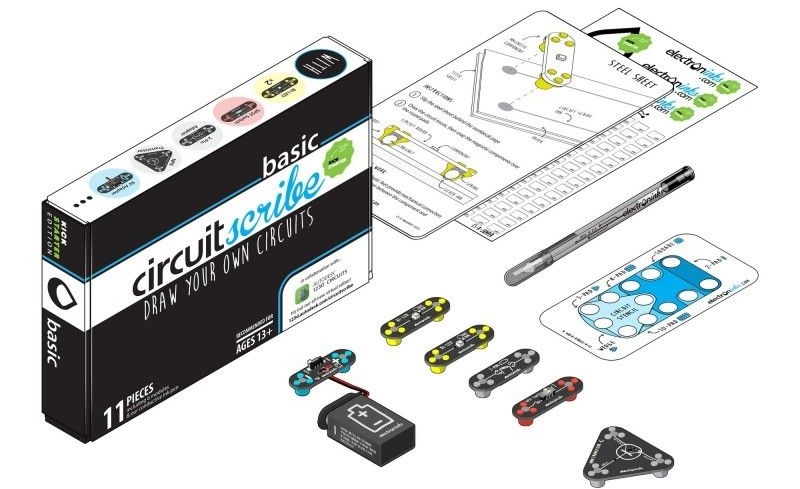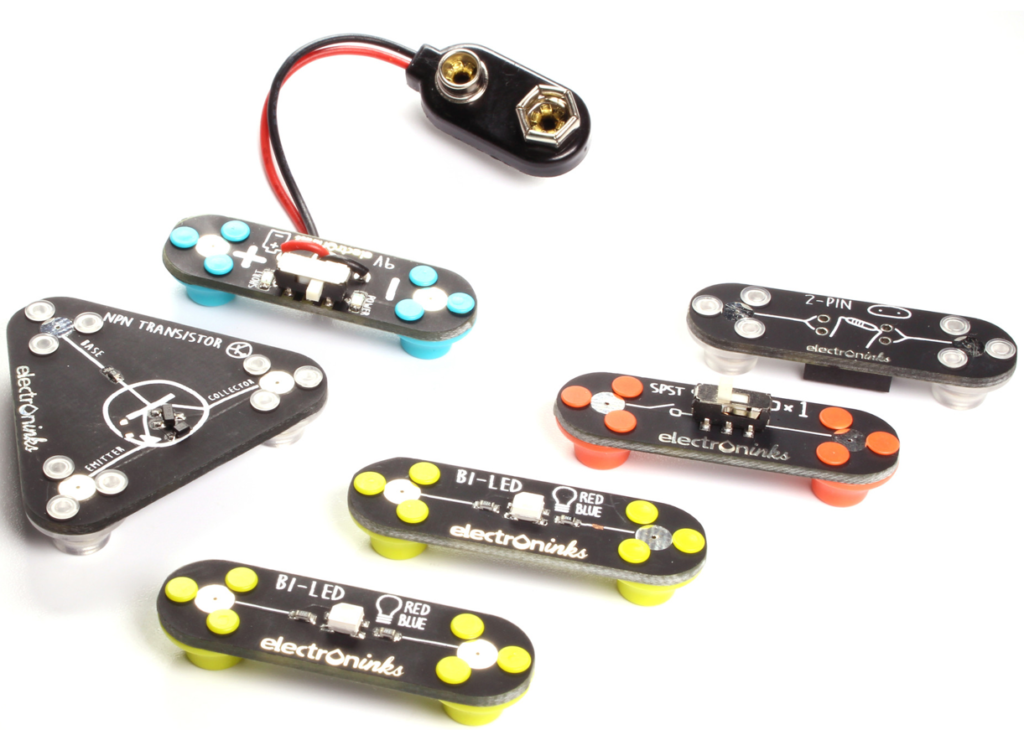
Scribe Circuits
Circuit Scribe is a silver conductive ink ballpoint pen that can be used to create circuits on flexible surfaces like paper.
Users can use a Circuit Scribe pen to draw lines on a simple sheet of paper in the same way they would draw a picture. They can then use special electrical components to connect to the painted lines, allowing electrical currents to flow through them. Breadboards and wires are no longer required.
Components:
- 9V Battery adapter with 9V battery
- x2 Bi-LED
- SPST Switch
- NPN Transistor
- 2-Pin Adapter with 5x resistors (100, 1k, 10k, 100k and 1M ohm), 2x capacitors (0.1uF, 1.0uF), and one photoresistor (10k ohms)
- Conductive Ink Pen
- Circuit Stencil
- Jumper Sticker Sheet
- Steel sheet
Working Principle:
A water-based, non-toxic conductive ink is used in the pen. The ink is made by combining an aqueous solution of silver nitrate with polyacrylic acid (PAA) and diethanolamine (DEA), the capping agent and reducing agent, respectively, in a flask of water.
Circuit Scribe can be used to create circuits that connect many sorts of modules or individual components, such as the following:
Power
- USB Power Adapter: Allows user to power the drawn circuits with either a USB port or a wall outlet.
- 9V Battery Adapter: Supplies a nine-volt power to the circuits.
Input
- SPST Switch: An on/off switch that allows users to control the electrical circuit.
- DPDT Switch: Two switches that direct the flow of current through the circuit.
- Light Sensor: Shines light on the phototransistor to control an output.
- Potentiometer 10k Ohm: A knob that controls the dimness, volume, and “speed” of circuit.
Connect
- 2-Pin Adapter: Allows user to connect resistors, capacitors, or sensors to circuits.
- NPN Transistor: An electrical amplifier that converts small signals into large currents.
- Blinker: Blinks output components on and off at adjustable rates.
- DIY Boards: Allows user to solder 2, 4, 6, or 8 pin components to the board.
- Connector Cables: Connects the paper circuit to DIY hardware platform.
Output
- Bi-LED: Two LEDs in one that can flip directions to change the color.
- Buzzer: Vibrates in response to the voltage.
- Motor: Rotates with an applied voltage.
- RGB LED: A red, blue, and green LED.

With its silver ink, the Circuit Scribe allows the user to draw electrical circuits in any shape. It is possible to create simple electronic circuits using this feature and its capacity to link various types of modules.
Instructions:
- Experiment building circuits by connecting different modules with the conductive ink pen.
Links:
https://www.botnroll.com/pt/robos-e-kits-educacionais/2130-circuit-scribe-basic-kit.html
https://www.youtube.com/watch?v=e0NM1jJbjrM
https://www.youtube.com/watch?v=yxV8XBwy-tY
https://www.youtube.com/watch?v=ewXrFq1eHAQ
https://en.wikipedia.org/wiki/Circuit_Scribe
https://circuitscribe.com/?_atid=6aNedJz1F09Vmj4jlaSwO6C1iKi8jY